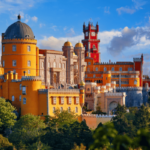Embark on a journey through Rome, where the whispers of the past meet modern vibrancy. The “Eternal City wonders” are not just relics; they are living stories waiting to be discovered. From ancient ruins that echo the might of empires to bustling piazzas brimming with contemporary life, Rome offers a timeless adventure that captivates the heart of every traveler.
Introduction: Embracing Rome’s Timeless Charm

When one dives into Rome, they immediately become enveloped in a tapestry of history and culture that is both awe-inspiring and humbling. The city’s ancient streets and monumental architecture serve as gateways to a bygone era, where every stone tells a story of glory, conquest, and human endeavor. This rich historical backdrop sets the stage for an exploration that transcends time, inviting wanderers to step into a world where history is alive.
Moreover, Rome’s charm lies not only in its illustrious past but also in its vibrant present. The city pulses with life, from the lively chatter of its open-air cafes to the spirited hustle of its markets. It’s a place where tradition and modernity intertwine seamlessly, creating a dynamic atmosphere that energizes even the weariest of travelers. The Eternal City’s wonders are as much about its spirited people and contemporary rhythms as they are about its ancient heritage.
In discussing the “Eternal City wonders,” it’s essential to recognize that Rome’s true essence lies in its ability to blend the epochs. The ancient Colosseum stands in harmony with modern structures, symbolizing the city’s ongoing narrative. This juxtaposition of the old and the new makes Rome a unique destination, where the past is not just remembered but actively part of the living, breathing fabric of the city.
Step Back in Time: Exploring Ancient Roman Ruins
Wandering through the heart of Rome, one is transported back to the days of the Roman Empire, amidst the colossal ruins that have withstood the test of time. The Forum, once the epicenter of Roman public life, now stands as a silent witness to the city’s grandeur and the complexities of its ancient society. Each ruin, from the majestic columns to the crumbling facades, narrates a chapter of Rome’s storied past, inviting onlookers to ponder the lives that once unfolded within these historic confines.
The Colosseum, perhaps the most iconic of Rome’s ancient structures, embodies the might and ingenuity of the Roman people. Its vast arena, where gladiators once battled, evokes images of a civilization both advanced and brutal. Visitors to this ancient amphitheater can almost hear the echoes of the crowds and the clash of swords, bridging centuries in a moment of vivid imagination. This architectural marvel not only showcases Roman engineering prowess but also serves as a poignant reminder of human endurance and creativity.
In exploring these ancient ruins, one engages with the “Eternal City wonders” in their most raw and evocative form. The Palatine Hill, with its imperial palaces, offers a glimpse into the domestic life of Rome’s rulers, while the Pantheon, with its magnificent dome, stands as a testament to the spiritual and architectural aspirations of the ancients. Each site offers a unique perspective on the daily life, beliefs, and accomplishments of a civilization that has profoundly shaped the Western world.
A Taste of Italy: Savoring Roman Cuisine
Embarking on a culinary journey through Rome is akin to taking a flavorful tour through Italy’s rich gastronomic landscape. The city’s trattorias and osterias serve as gateways to authentic Roman fare, where traditional dishes like carbonara and amatriciana are not just meals but a celebration of local ingredients and time-honored recipes. Each bite is a testament to the city’s love affair with food, inviting diners to indulge in a sensory feast that tantalizes the palate and warms the soul.
Moreover, Rome’s markets are bustling epicenters of flavor, offering fresh produce, artisan cheeses, and an array of cured meats that reflect the regional diversity of Italian cuisine. The Campo de’ Fiori market, with its vibrant stalls and spirited vendors, is a culinary treasure trove, where the simple act of shopping becomes an exploration of flavors and aromas. Here, food is more than sustenance; it’s a way of life, deeply woven into the fabric of Roman culture.
In delving into the “Eternal City wonders,” one must not overlook the gelaterias that dot the cityscape, offering respite from the Mediterranean sun with their creamy, artisanal gelato. Each scoop is a blend of tradition and innovation, with flavors ranging from classic chocolate and stracciatella to more adventurous combinations inspired by local fruits and desserts. Rome’s culinary scene is a dynamic mosaic of tastes, inviting visitors to embark on a gastronomic adventure that feeds both the body and the spirit.
Spiritual Journey: Vatican City’s Sacred Sites

Nestled within the heart of Rome, Vatican City emerges as a sovereign sanctuary, offering a spiritual odyssey unlike any other. This tiny city-state, the epicenter of the Catholic world, is home to some of the most revered sacred sites, including the awe-inspiring St. Peter’s Basilica. Visitors envelop themselves in an atmosphere of reverence and beauty, where art and spirituality intertwine to create an experience that uplifts the soul and inspires awe.
Furthermore, the Vatican Museums present a journey through centuries of religious and artistic achievements. The Sistine Chapel, with Michelangelo’s breathtaking ceiling, stands as a testament to the divine interplay between human creativity and spiritual pursuit. Each corridor and gallery in the museums tells a story of faith, showcasing a collection that spans from ancient Egyptian relics to Renaissance masterpieces, inviting pilgrims and art lovers alike to traverse a path of beauty and devotion.
The “Eternal City wonders” are perhaps most profoundly felt within the hallowed grounds of Vatican City, where history, art, and spirituality converge. The ethereal beauty of the Vatican Gardens, a lesser-known oasis, offers a tranquil retreat from the bustling city, allowing visitors to reflect and find peace amidst the verdant landscapes and quiet sanctuaries. Vatican City is not just a destination; it’s a pilgrimage, where each step brings one closer to the essence of faith and human artistic expression.
Renaissance and Beyond: Rome’s Artistic Heritage
The pivotal role of Rome in the Renaissance deeply enriches its narrative, a period that redefined the boundaries of artistic expression. The city’s galleries and churches are adorned with works by masters like Michelangelo, Raphael, and Caravaggio, whose genius continues to captivate visitors. Each masterpiece, whether a fresco in a secluded chapel or a statue in a public square, is a testament to Rome’s enduring influence on the art world.
Beyond the Renaissance, Rome’s artistic legacy stretches into the Baroque period and beyond, offering a continuum of stylistic evolution. The intricate details of Bernini’s sculptures and the dramatic use of light in Caravaggio’s paintings exemplify the city’s contribution to the Baroque movement. This artistic richness offers a layered experience of Rome, where each era’s aesthetic contributions are woven into the city’s architectural and cultural fabric, providing a feast for the senses.
The exploration of “Eternal City wonders” through its art is not just about viewing; it’s about engaging with the historical and cultural narratives that these works embody. From the grandeur of the Vatican’s art collections to the intimate charm of a Caravaggio in a quiet church, Rome invites visitors to journey through time, witnessing the evolution of artistic thought and its profound impact on human history and spirituality.
The Heart of Rome: Piazzas and Public Life
Rome’s piazzas are the city’s beating heart, vibrant stages where the drama of daily life unfolds against a backdrop of historic architecture. The Piazza Navona, with its elegant fountains and baroque palaces, encapsulates the spirit of Roman public spaces. Here, locals and tourists alike mingle, drawn by the allure of street artists, quaint cafes, and the pulsating energy that defines the Eternal City’s public life.
Transitioning to the majestic Piazza di Spagna, the grand staircase of the Spanish Steps offers a picturesque setting that has inspired poets and painters alike. The steps, a melting pot of languages and cultures, provide a unique vantage point to observe the city’s rhythm. As the sun sets, the steps become a gathering place for people to share stories and admire the beauty of Rome, further highlighting the piazzas’ role in fostering community and connection.
Moreover, the Piazza del Popolo, with its ancient obelisk and twin churches, serves as a gateway to Rome’s rich history and vibrant modern life. This expansive square, often host to concerts and cultural events, showcases the dynamic interplay between Rome’s past and present. The “Eternal City wonders” are vividly on display in these public squares, where history, culture, and the vibrancy of Roman life converge, offering an open-air museum of unparalleled beauty and energy.
Unveiling the Hidden: Rome’s Lesser-Known Treasures
Amidst Rome’s famed landmarks lies a labyrinth of hidden gems, each with stories whispering of the city’s layered past. The quiet courtyards, secluded gardens, and ancient pathways offer a retreat from the well-trodden tourist paths. These lesser-known treasures, like the tranquil Orange Garden on Aventine Hill, provide a serene vista of the city, revealing a Rome that exists beyond the guidebooks, waiting to be discovered by those who venture off the beaten track.
Further exploration unveils places like the Quartiere Coppedè, an architectural wonderland that blends Art Nouveau, medieval, and Baroque elements. This whimsical district, with its fairytale-like facades and ornate decorations, transports visitors to a world where imagination reigns. Such hidden corners of Rome offer a glimpse into the eclectic tastes of the city’s past architects and patrons, showcasing a diversity of styles that enrich Rome’s urban tapestry.
The “Eternal City wonders” also lie in its lesser-known historical sites, such as the Baths of Caracalla, whose ancient ruins provide a quiet space to ponder the grandeur of Rome’s imperial era. These off-the-beaten-path locations invite a deeper connection with the city, encouraging a more personal exploration of its history and culture. Rome’s hidden treasures are integral to understanding the city’s soul, offering intimate encounters with its enduring spirit.
Echoes of the Past: Rome’s Historical Landmarks

Rome’s landscape is a mosaic of historical landmarks, each echoing the tales of empires, popes, and revolutions that have shaped the city’s destiny. The imposing Castel Sant’Angelo, originally a mausoleum for Emperor Hadrian, stands guard by the Tiber River, its storied walls having witnessed the ebb and flow of Rome’s fortunes. This fortress, now a museum, offers a panoramic view of Rome’s history, layered within its chambers and corridors.
Transitioning from imperial tombs to sacred sites, the Basilica di Santa Maria Maggiore represents the spiritual heritage interwoven with Rome’s historical narrative. This ancient church, adorned with golden mosaics and exquisite artworks, serves as a testament to Rome’s enduring faith and artistic patronage. It’s a place where the divine and the earthly converge, inviting visitors to reflect on the city’s capacity to inspire awe through its devotion to beauty and spirituality.
Furthermore, the “Eternal City wonders” resonate within the ancient walls of the Roman Ghetto, Rome’s historic Jewish quarter. Here, narrow lanes and traditional kosher eateries tell the story of a community that has contributed to Rome’s cultural fabric for centuries. The area’s rich history, marked by both hardship and resilience, adds a profound depth to Rome’s identity, showcasing the city’s diverse influences and the strength of its people.
After Dark: Experiencing Roman Nightlife
As the sun sets, Rome sheds its historical cloak, revealing a vibrant nightlife that pulsates through its ancient streets and modern venues. The transformation is palpable in districts like Trastevere, where the cobblestone lanes come alive with the buzz of outdoor cafes, bars, and the melodies of street musicians. This lively neighborhood offers a blend of local charm and youthful energy, making it a favorite among both Romans and visitors looking to experience the city’s nocturnal vibes.
Moving towards the city center, the Campo de’ Fiori area presents a more eclectic nightlife scene. Here, the day’s bustling market gives way to a lively social hub, where people gather to enjoy aperitivos and the laid-back atmosphere. The mix of historic backdrop and contemporary socializing creates a unique setting for an evening out, reflecting Rome’s ability to marry the past with the present in its ever-evolving social landscape.
Moreover, Rome’s nightlife isn’t confined to bars and piazzas; the city also offers a variety of cultural events after dark, from open-air concerts at ancient sites to art exhibitions and theater performances. These events highlight the “Eternal City wonders” under a new light, offering immersive experiences that blend entertainment with education and appreciation for the arts. Rome after dark is a testament to the city’s dynamic spirit, where history and modernity dance together into the early hours.
Festivals and Celebrations: Rome’s Cultural Calendar
Festivals and celebrations richly embroider Rome’s calendar, bringing the city’s history and traditions to life. The annual Festa della Repubblica, marking Italy’s day of independence, is a spectacle of parades and patriotic fervor, showcasing the national spirit. These events offer a window into the Italian way of life, where history is not just remembered but actively celebrated, reinforcing the communal bonds that define the city’s social fabric.
In spring, the city blooms not only with flowers but also with cultural festivities like the Rome Film Festival, which transforms the Eternal City into a cinematic hub. This celebration of film and creativity attracts movie buffs and industry insiders from around the globe, adding a contemporary layer to Rome’s artistic heritage. It’s a time when the city’s ancient streets and modern theaters converge in a shared appreciation for the storytelling arts.
Moreover, religious festivals such as Easter week in Rome offer profound experiences that blend solemn rituals with communal joy. The “Eternal City wonders” during this time are illuminated by spiritual ceremonies and historic traditions, from the Pope’s Mass at St. Peter’s Basilica to the Via Crucis procession at the Colosseum. These events underscore Rome’s role as a spiritual center, inviting believers and curious visitors alike to partake in its sacred observances.
Conclusion
Embarking on a journey through Rome is to walk in the footsteps of history, art, and culture that have shaped not only the city but the world. The Eternal City, with its labyrinth of ancient streets, majestic ruins, and vibrant piazzas, offers an unparalleled exploration of humanity’s enduring achievements. So each corner of Rome tells a story, inviting travelers to delve into the rich tapestry of its past and present.
Moreover, the essence of Rome extends beyond its tangible wonders to the intangible spirit that pervades its air. The warmth of its people, the richness of its cuisine, and the liveliness of its traditions contribute to the city’s soul, making every visit a multifaceted experience. The “Eternal City wonders” are not just relics to be admired but experiences to be lived, blending the echoes of the past with the vibrant pulse of the present.
In conclusion, Rome stands as a testament to the beauty and complexity of human civilization, a city where every street, building, and monument tells a part of our collective story. Its enduring charm and timeless wonders continue to captivate the hearts and minds of those who wander its ancient paths, leaving an indelible mark on all who embrace its history and vitality.
II. Frenquently Asked Questions About Italy
- What's the best way to experience Italy's beautiful coastline?Experience Italy's coastline by visiting the Amalfi Coast, Cinque Terre, or Sardinia for stunning views and relaxation.
- Are there any famous Italian fashion districts or outlets worth visiting?Shop for high-end fashion in Milan's Quadrilatero della Moda or find designer outlets in Florence and Tuscany.
- What are some etiquette tips for interacting with locals in Italy?Respect Italian customs by greeting locals with "Buongiorno" or "Buonasera" and using "grazie" and "prego" politely.
- How can I stay safe while traveling in Italy?Stay safe by being vigilant of pickpockets in crowded areas and following local guidelines, especially in urban centers.
- What are the visa requirements for visiting Italy as a tourist?Check visa requirements based on your nationality and the duration of your stay in Italy.
- Can you recommend some off-the-beaten-path destinations in Italy?Explore lesser-known destinations like Matera, Puglia, or the Dolomites for unique cultural and natural experiences.
- What are the best months to visit Italy in terms of weather and crowds?Visit Italy in spring or fall to avoid crowds and enjoy pleasant weather for sightseeing and outdoor activities.
- Are there any UNESCO World Heritage Sites in Italy that are particularly worth visiting?Explore UNESCO sites like the historic center of Rome, the Cinque Terre, or the archaeological areas of Pompeii.
- What are the options for accommodation in Italy, and which areas are best for each budget?Accommodation options range from luxury hotels in major cities to cozy agriturismos in rural areas.
- How can I learn about Italy's history and art during my visit?Learn about Italy's history and art through guided tours of museums, churches, and archaeological sites.

Ryan Taylor, a seasoned traveler with over a decade of experience exploring Europe’s nooks and crannies, offers a wealth of knowledge and unique insights into the continent’s diverse cultures and landscapes. His passion for travel began in his early twenties, and since then, Ryan has journeyed through numerous European countries, collecting stories, tips, and a deep understanding of each destination’s unique charm. His blog entries are not just guides but narratives enriched with personal experiences, making every recommendation and piece of advice relatable and practical for fellow travel enthusiasts. With a keen eye for hidden gems and a love for sharing his adventures, Ryan’s writings are a treasure trove for anyone seeking to discover the beauty and richness of Europe.






